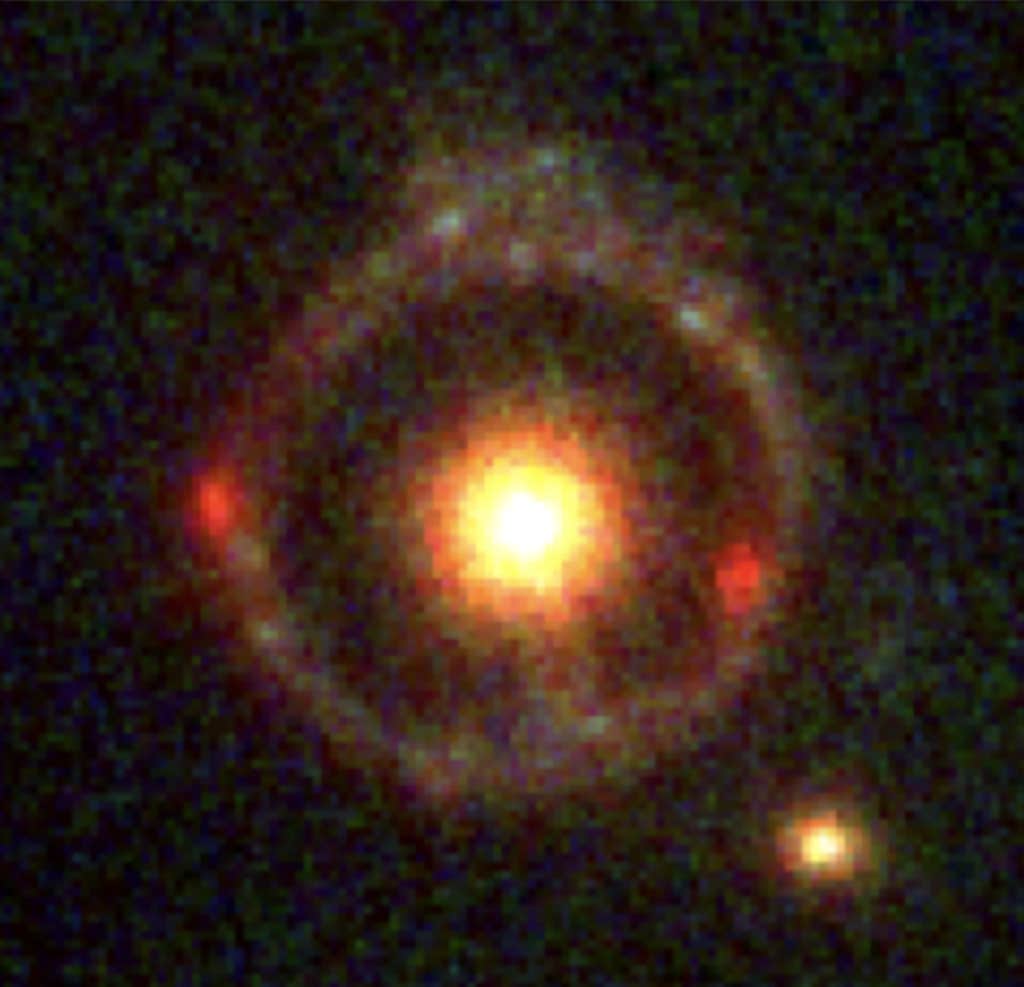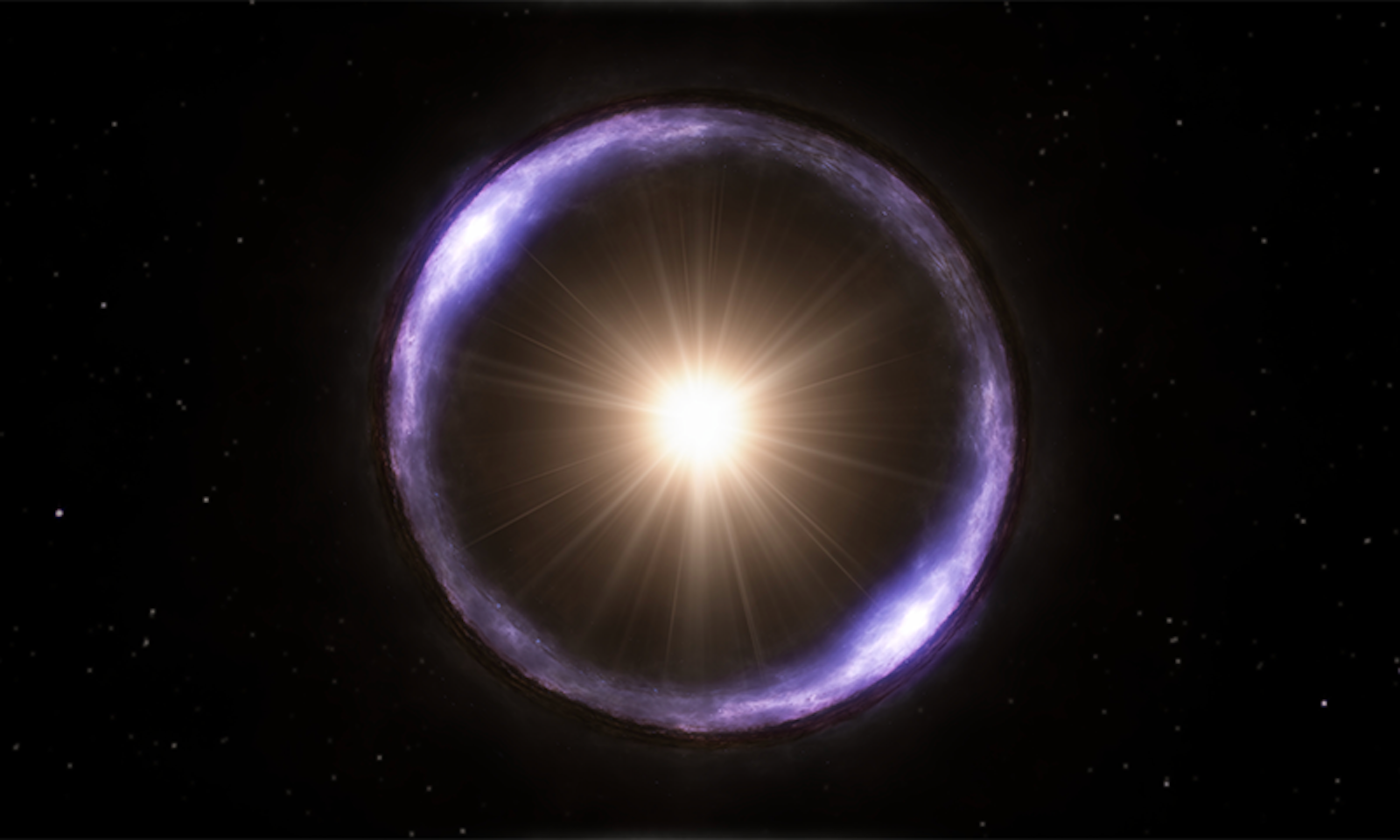Not long ago, Pieter van Dokkum received a delightful invitation. Would he like to have a look at new images of the universe no one has ever seen? Yes, he would. Within a few days, van Dokkum, a Yale University astrophysicist, and his former student, Gabriel Brammer, an astrophysicist at the University of Copenhagen spotted, in a mosaic image taken by the James Webb Space Telescope, one of the rarest of space oddities: a complete Einstein ring. A shining halo of light—a trick of gravity—that occurs when two galaxies line up perfectly, one behind the other, in our sky.
This is one of the wonderful things about Einstein rings. “There’s actually nothing there, where you see the ring,” van Dokkum says. If you were traveling in a spaceship toward it, the Einstein ring would seem to get larger at first, but then it would slowly disappear. “That’s the mind-bending aspect,” he says. So mind-bending that Einstein himself once referred to the idea of a complete observable ring as a “science-fiction effect.” They only exist, as Obi-wan would say, from a certain point of view. And yet, by analyzing their size, researchers can decipher clues about some of the more vexing questions in the universe, such as when giant galaxies began forming and the mysterious nature of dark matter.

If Einstein rings are rare, complete ones—like this one, that van Dokkum and colleagues detailed in Nature Astronomy in October—are almost unheard of. Tony Stark, (not Iron Man but) an astronomer and cosmologist at the Harvard Smithsonian Center for Astrophysics, explains that it’s “unusual for the chance alignment to be so good that a nice, round ‘Einstein Ring’ is produced.” Einstein rings are “the most elegant manifestation,” as NASA puts it, of a beguiling astrophysical phenomenon called gravitational lensing.
The massive galaxy closer to us—the dot in the ring—is acting like a giant lens. A lens, like a magnifying glass, can alter how an object appears by affecting the path light takes to our eyes or instruments. Magnifying glasses focus light rays together, which make an object appear larger, or closer, than it really is. Van Dokkum says what happens with gravitational lenses is that a lot of light rays that would otherwise pass by the Earth (or, in the case of a magnifying glass, not fall on your retina), get bent toward us. “That magnifies the total amount of light that we get from these objects. Gravitational lenses do exactly what an optical lens does—they magnify,” van Dokkum says. “You can get these images of distant galaxies with much higher resolution and intensity than we otherwise would be able to get, even with James Webb.”
The galaxy acting like a lens at the center of the Einstein ring van Dokkum found is the most distant lens ever discovered, at least at the time they spotted it. Its light had been traveling for 10 billion years, appearing as a dot within the ring. The light from the ring itself had been traveling for 11.5 billion years.
Dark matter is the stuff that holds galaxies together.
Van Dokkum says the complete Einstein ring offers “further evidence that massive galaxies started forming very early in the history of the universe.” This has been a niggling question on the minds of many cosmologists since early 2023 when Webb Telescope images showed unexpectedly large galaxies hanging around soon after the Big Bang. According to current cosmological models, van Dokkum says, the massive galaxies shouldn’t have had time to form that early. “The big question of those is: What is their mass? How heavy are they?” he says. “This galaxy inside the ring is a descendant of those very early galaxies. But instead of finding that we overestimated the masses, it looks like we may have underestimated the masses—so, exacerbating the problems, if you will, in understanding how so much mass could form so early” in the history of the universe.
Claudia de Rham, a theoretical physicist at Imperial College London and author of the forthcoming memoir The Beauty of Falling: A Life in Pursuit of Gravity, says this complete Einstein ring offers a new cosmic tool. “It allows us to infer the mass of the objects between the source and us, and get a much more precise mapping of the matter distribution in the universe,” she explained in an email. And some of that matter seems to be behaving differently than expected. “In this case, it is remarkable that the observed level of lensing seems to suggest a higher than standard dark matter density at that scale.”
Dark matter is the stuff that holds galaxies together. Without it, they’d fling apart, disintegrate, by the force of their rotation. Something, some amount of mass, has to be keeping them whole, something other than the mass scientists can observe, because the amount of matter they can see doesn’t exert enough gravity to counterbalance galaxies’ spin. This something-else is “dark,” and hard to study, because it doesn’t seem to interact with light in any way. Scientists don’t yet know how to directly detect the stuff, but they can estimate how much dark matter a galaxy should have, given the amount of mass that’s visible in stars. Which is where Einstein rings come in.
They offer scientists another way to estimate the mass of a galaxy—by measuring how dramatically it is lensing a galaxy behind it. Rare, complete rings give researchers the opportunity to make a clean measurement of the ring’s diameter, and thus how massive the lensing galaxy must be to produce that effect. The bigger the ring, the more mass—some of it coming in the form of dark matter—the lensing foreground galaxy must have. And that can usefully differ from the mass estimate scientists might make from a galaxy’s visible stars plus the amount of dark matter the galaxy should have. Researchers have even used Einstein rings to assess what sort of material dark matter might be, based on how different material might look after getting distorted by a gravitational lens.
If Einstein rings are rare, complete ones are almost unheard of.
From a stargazer’s perspective, the ring van Dokkum and his team found is absolutely minuscule. You wouldn’t even be able to see the ring with the most powerful ground-based telescope, because Earth’s atmosphere would distort the image. “It would just be a blob,” van Dokkum says. Yet the ring was bigger than he expected.
“Even if you account for dark matter, we can’t quite explain the large diameter of this ring,” van Dokkum says. He surmises that, judging by the ring’s size, the galaxy in the middle of it—the bright dot in the image—has to have something like 10 times the mass of our own galaxy, the Milky Way. “It’s partly dark matter, partly stars that we see. But there must be something else.” The size of the Einstein ring suggests the lensing galaxy has more mass than the amount of visible stars in the galaxy could add up to.
“They’re different by a factor of about six. That’s weird,” says Chiara Mingarelli, an astrophysicist at Yale University. She liked the way van Dokkum tried to suss out how much of the missing mass in the galaxy might be dark matter, or something else. “If I say that it’s all dark matter—can I actually explain it that way?” she says. Not entirely. It’s a better match—between the mass that the ring size indicates, and the mass that the visible stars indicate plus some dark matter. “But it’s still not clear that it’s actually all dark matter. The tension is there. They can’t solve it.”
One possibility is that there are tons of stars hiding near the center of the massive galaxy that our instruments can’t quite detect. “Maybe there’s stars there that are half a solar mass that aren’t very luminous,” Mingarelli says. “If you could see them, then you would get the right number.” Another possibility is that van Dokkum and his colleagues aren’t accounting for all the dark matter. “We use computer simulations to estimate how much dark matter there should be,” he says. “Maybe we’re missing dark matter. But that’s a puzzle that requires further data.”
The Einstein ring also got van Dokkum to reflect on the way he and his colleagues often work. “Now that astronomy has turned into this big science, we get giant datasets, and we run automated algorithms to find millions of objects. Which is all great and very important. But you cannot be surprised easily that way,” he says. “You cannot find things you don’t expect easily,” because you’re not looking at real images with your naked eyes. For that reason, Van Dokkum says the way he and Brammer stumbled upon the ring was, “in a way, very old fashioned.” They were mining for gold in a viewer for Webb images Brammer had made that you can pan around in, and zoom in and out, “like Google Maps,” while cheerfully chatting over the messaging app Slack about what they were seeing.
“Just looking at data, for me, it’s a joy,” he says. “I hope that, for my students, these kinds of discoveries inspire them, when they get an image from the universe, to also take a look. There’s a lot out there. The universe is filled with wonders.” ![]()
Lead image: IncrediVFX / Shutterstock




























